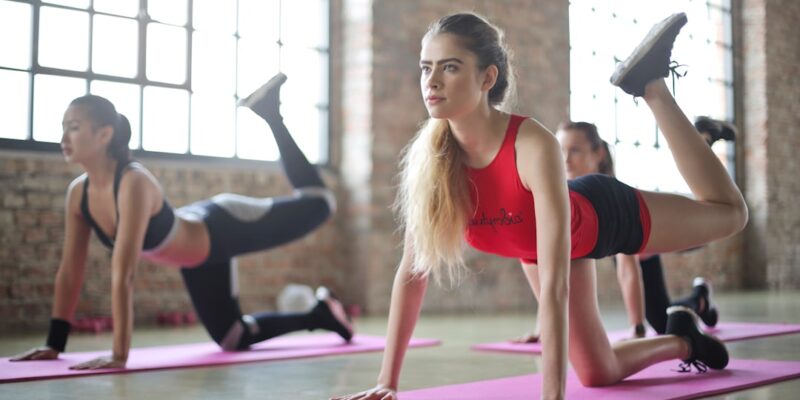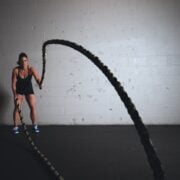
Get Stronger and Leaner with this Printable Dumbbell Workout Plan
Dumbbell workouts have become increasingly popular in recent years, and for good reason. These versatile pieces of equipment offer a wide range of benefits for individuals looking to improve their strength, build muscle, and enhance their overall fitness level. Incorporating dumbbell workouts into your fitness routine can lead to a stronger, healthier body.
One of the main benefits of dumbbell workouts is that they allow for a greater range of motion compared to other types of weightlifting exercises. This means that you can target specific muscle groups more effectively and engage more muscles during each exercise. Dumbbells also require more stabilization from your muscles, which can help improve your balance and coordination.
Additionally, dumbbell workouts are highly adaptable and can be modified to suit any fitness level. Whether you are a beginner or an experienced lifter, you can adjust the weight and intensity of the exercises to challenge yourself and continue making progress. This makes dumbbell workouts suitable for individuals of all ages and fitness levels.
Key Takeaways
- Dumbbell workouts offer numerous benefits for overall fitness and strength.
- Proper form and technique are crucial to prevent injury and maximize results.
- Warm-up exercises are essential to prepare your body for the workout.
- Upper body, lower body, and core exercises can all be done with dumbbells for a full-body workout.
- Combining dumbbell workouts with cardio can lead to even greater results.
The Importance of Proper Form and Technique
While dumbbell workouts offer numerous benefits, it is crucial to prioritize proper form and technique to avoid injury and maximize results. Using improper form can put unnecessary strain on your joints and muscles, increasing the risk of injury.
To maintain proper form during dumbbell exercises, it is important to start with a weight that you can comfortably lift without compromising your form. This will ensure that you are able to perform the exercises with proper technique and minimize the risk of injury.
Another key aspect of maintaining proper form is focusing on your posture throughout each exercise. Keep your back straight, shoulders down and back, and engage your core muscles to stabilize your body. Avoid using momentum or swinging the weights, as this can lead to improper form and reduce the effectiveness of the exercise.
Warm-up Exercises to Prepare Your Body
Before diving into a dumbbell workout, it is essential to warm up your body to prepare it for the upcoming physical activity. Warming up helps increase blood flow to your muscles, improves flexibility, and reduces the risk of injury.
Some effective warm-up exercises that can be done before a dumbbell workout include jogging in place, jumping jacks, arm circles, and bodyweight squats. These exercises help elevate your heart rate, increase circulation, and activate the muscles you will be using during your workout.
It is also beneficial to incorporate dynamic stretches into your warm-up routine. Dynamic stretches involve moving your muscles and joints through a full range of motion. Examples of dynamic stretches include leg swings, arm swings, and torso twists. These stretches help improve flexibility and mobility, preparing your body for the movements you will be performing during your dumbbell workout.
Upper Body Dumbbell Exercises for Stronger Arms, Chest, and Back
| Exercise | Muscles Worked | Repetitions | Sets | Weight |
|---|---|---|---|---|
| Bicep Curl | Biceps | 10-12 | 3-4 | 10-20 lbs |
| Tricep Extension | Triceps | 10-12 | 3-4 | 10-20 lbs |
| Shoulder Press | Shoulders | 10-12 | 3-4 | 10-20 lbs |
| Chest Press | Chest, Triceps, Shoulders | 10-12 | 3-4 | 10-20 lbs |
| Bent Over Row | Back, Biceps | 10-12 | 3-4 | 10-20 lbs |
Dumbbell exercises are highly effective for targeting the muscles in your upper body, including your arms, chest, and back. Incorporating these exercises into your fitness routine can help strengthen and tone these muscle groups.
Some effective dumbbell exercises for the upper body include bicep curls, tricep kickbacks, shoulder presses, chest presses, and bent-over rows. These exercises can be performed with dumbbells of varying weights to challenge different muscle groups.
Bicep curls target the muscles in the front of your upper arms (biceps), while tricep kickbacks focus on the muscles in the back of your upper arms (triceps). Shoulder presses work the deltoid muscles in your shoulders, while chest presses target the pectoral muscles in your chest. Bent-over rows engage the muscles in your back, including your lats and rhomboids.
Performing these exercises with proper form and technique will help you build strength and definition in your upper body. Start with lighter weights and gradually increase the weight as you become more comfortable and stronger.
Lower Body Dumbbell Exercises for Toned Legs and Glutes
In addition to targeting the upper body, dumbbell exercises can also be used to strengthen and tone the muscles in your lower body, including your legs and glutes. These exercises can help improve your lower body strength, stability, and overall athletic performance.
Some effective dumbbell exercises for the lower body include goblet squats, lunges, deadlifts, and step-ups. Goblet squats target the muscles in your thighs (quadriceps) and glutes, while lunges work the same muscle groups along with your hamstrings. Deadlifts engage the muscles in your hamstrings, glutes, and lower back, while step-ups target your quadriceps and glutes.
When performing these exercises, it is important to maintain proper form and technique. Keep your knees aligned with your toes during squats and lunges, and avoid letting them collapse inward. Engage your core muscles to stabilize your body and maintain a neutral spine throughout each exercise.
Core Strengthening Dumbbell Exercises for a Stronger Midsection
A strong core is essential for overall strength and stability. Dumbbell exercises can be used to target the muscles in your core, including your abdominals, obliques, and lower back.
Some effective dumbbell exercises for the core include Russian twists, woodchoppers, weighted planks, and seated twists. Russian twists target your obliques, woodchoppers engage your obliques and abdominals, weighted planks work your entire core, and seated twists focus on your obliques.
To perform these exercises effectively, focus on engaging your core muscles throughout each movement. Maintain proper form and avoid using momentum or swinging the weights. Start with lighter weights and gradually increase the weight as you become stronger.
Combining Cardio and Dumbbell Workouts for Maximum Results
While dumbbell workouts are effective on their own, combining them with cardiovascular exercises can help maximize your results and improve your overall fitness level. Cardiovascular exercises help increase your heart rate, burn calories, and improve your cardiovascular endurance.
To incorporate cardio into your dumbbell workout, you can perform exercises such as dumbbell thrusters, dumbbell burpees, or dumbbell step-ups with a higher intensity or faster pace. These exercises will elevate your heart rate and challenge your cardiovascular system while also engaging your muscles.
Another option is to alternate between sets of dumbbell exercises and short bursts of cardio, such as jumping jacks or high knees. This will keep your heart rate elevated throughout the workout and provide a more well-rounded fitness routine.
Cool-down Stretches to Prevent Injury and Promote Flexibility
After completing a dumbbell workout, it is important to cool down and stretch your muscles to prevent injury and promote flexibility. Cooling down helps gradually lower your heart rate and allows your body to return to its resting state.
Some effective cool-down stretches that can be done after a dumbbell workout include standing quad stretches, seated forward folds, chest stretches, and tricep stretches. These stretches help lengthen and relax the muscles you worked during your workout.
It is important to hold each stretch for at least 20-30 seconds and breathe deeply to allow your muscles to relax and release tension. Avoid bouncing or forcing the stretch, as this can lead to injury.
Tips for Progressing and Increasing Weight and Repetitions
To continue seeing progress and avoid plateauing in your dumbbell workouts, it is important to progressively increase the weight and repetitions over time. This will challenge your muscles and stimulate further strength gains.
Start by selecting a weight that allows you to perform the exercise with proper form for the desired number of repetitions. As you become stronger, gradually increase the weight by small increments. Aim to increase the weight by 5-10% every 1-2 weeks.
In addition to increasing the weight, you can also increase the number of repetitions or sets you perform. This will further challenge your muscles and help you continue making progress. However, it is important to listen to your body and avoid overtraining. Allow for adequate rest and recovery between workouts to prevent injury and promote muscle growth.
Incorporating Dumbbell Workouts into Your Fitness Routine
Incorporating dumbbell workouts into your fitness routine can offer a wide range of benefits for your overall health and well-being. These exercises can help improve your strength, build muscle, enhance your cardiovascular endurance, and promote flexibility.
By prioritizing proper form and technique, warming up before each workout, targeting different muscle groups with upper body, lower body, and core exercises, incorporating cardio for maximum results, cooling down and stretching after each workout, and progressively increasing the weight and repetitions over time, you can optimize your dumbbell workouts and continue making progress.
So why not give dumbbell workouts a try? Whether you are a beginner or an experienced lifter, incorporating dumbbell exercises into your fitness routine can lead to a stronger, healthier body. Challenge yourself, stay consistent, and enjoy the benefits of this versatile form of exercise.
Looking for more fitness inspiration? Check out this informative article on Wave Magnets’ website that explores the benefits of using resistance bands in your workout routine. Resistance bands are a versatile and portable alternative to traditional dumbbells, allowing you to target different muscle groups and increase the intensity of your exercises. Discover how to incorporate resistance bands into your printable dumbbell workout by clicking here. For more fitness tips and resources, visit Wave Magnets’ website at https://wavemagnets.com/.
FAQs
What is a printable dumbbell workout?
A printable dumbbell workout is a set of exercises that can be performed using dumbbells and can be printed out for easy reference.
What are the benefits of a dumbbell workout?
Dumbbell workouts can help build strength, increase muscle mass, improve bone density, and burn calories.
What equipment do I need for a dumbbell workout?
You will need a set of dumbbells and a workout bench or stability ball.
What are some exercises that can be included in a dumbbell workout?
Some exercises that can be included in a dumbbell workout are bicep curls, tricep extensions, shoulder presses, chest presses, squats, lunges, and deadlifts.
How many sets and reps should I do for each exercise?
The number of sets and reps will depend on your fitness level and goals. A general guideline is to do 3-4 sets of 8-12 reps for each exercise.
Can a dumbbell workout be modified for beginners?
Yes, a dumbbell workout can be modified for beginners by using lighter weights and performing fewer sets and reps.
Is it necessary to warm up before a dumbbell workout?
Yes, it is important to warm up before a dumbbell workout to prevent injury and prepare your muscles for exercise. A warm-up can include light cardio and dynamic stretching.
How often should I do a dumbbell workout?
The frequency of your dumbbell workouts will depend on your fitness level and goals. A general guideline is to do strength training exercises 2-3 times per week, with at least one day of rest in between workouts.

















